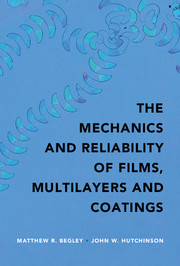Book contents
- Frontmatter
- Contents
- Acknowledgements
- Notation
- 1 Introduction
- 2 Key Mechanics Concepts
- 3 Linear Elastic Fracture Mechanics
- 4 Steady-State Delamination of Bilayers
- 5 Steady-State Delamination in Multilayers
- 6 Steady-State Channeling and Tunneling Cracks
- 7 Crack Kinking from an Interface
- 8 Crack Penetration, Deflection or Arrest?
- 9 Edge and Corner Interface Cracks
- 10 Buckling Delamination
- 11 Delamination of Thin Strips (Patterned Lines)
- 12 Delamination in Multilayers Subject to Steady-State Temperatures
- 13 Cracking under Transient Temperature Distributions
- 14 Software for Semi-Infinite Multilayers: Steady-State Delamination
- 15 Software for Semi-Infinite Multilayers: Transient Delamination
- 16 Finite Element Software for Multilayers: LayerSlayer FEA
- 17 Convergence and Benchmarks with LayerSlayer FEA
- Appendix Asymptotic Crack Tip Displacement Fields for an Interface Crack
- References
- Index
9 - Edge and Corner Interface Cracks
Published online by Cambridge University Press: 13 July 2017
- Frontmatter
- Contents
- Acknowledgements
- Notation
- 1 Introduction
- 2 Key Mechanics Concepts
- 3 Linear Elastic Fracture Mechanics
- 4 Steady-State Delamination of Bilayers
- 5 Steady-State Delamination in Multilayers
- 6 Steady-State Channeling and Tunneling Cracks
- 7 Crack Kinking from an Interface
- 8 Crack Penetration, Deflection or Arrest?
- 9 Edge and Corner Interface Cracks
- 10 Buckling Delamination
- 11 Delamination of Thin Strips (Patterned Lines)
- 12 Delamination in Multilayers Subject to Steady-State Temperatures
- 13 Cracking under Transient Temperature Distributions
- 14 Software for Semi-Infinite Multilayers: Steady-State Delamination
- 15 Software for Semi-Infinite Multilayers: Transient Delamination
- 16 Finite Element Software for Multilayers: LayerSlayer FEA
- 17 Convergence and Benchmarks with LayerSlayer FEA
- Appendix Asymptotic Crack Tip Displacement Fields for an Interface Crack
- References
- Index
Summary
Chapters 4 and 5 cover delamination in multilayers that have interface crack lengths that are extremely large in comparison to other dimensions, in which case the energy release rate becomes independent of the crack size (i.e., the steady-state limit). However, when the interface crack length is comparable to other dimensions in the problem, the energy release rate generally depends on the interface crack length, and as such, numerical solutions are needed. This chapter describes the relationship between crack length and crack tip parameters, and in so doing provides guidelines that identify crack lengths for which the steady-state solution is accurate.
The focus of coverage is on plane strain (two-dimensional) geometries, with a limited discussion of an interface crack at the corner of a thin film, which is inherently three-dimensional. It will be demonstrated that the two-dimensional results provide the necessary insight for most cases of interest. The two-dimensional results in this chapter were generated using the software described in Chapter 16 and are essentially a reiteration of the results in original papers by Zhuk, Evans, Hutchinson & Whitesides (1998) and Yu, He & Hutchinson (2001). Related coverage of three-dimensional problems is also provided in Chapter 11, which addresses interface cracks between a semi-infinite substrate and patterned lines, that is, thin film strips bonded to very thick substrates.
Interface Edge-Cracks: The Transition to Steady State
Consider the interface cracks located at the edge of a film bonded to a substrate, as illustrated in Figure 9.1. One of the remarkable aspects of thin film mechanics is how quickly a short edge-crack approaches the steady-state limit for a semi-infinite crack. The rapidity of this transition depends on whether the film edge is aligned with the edge of the substrate, as in Figure 9.1(a), or whether the film edge is interior to the edge of the substrate, as in Figure 9.1(b). In this section, we focus on two-dimensional film/substrate systems in plane strain with an infinitely long crack front in the out-ofplane direction. A limited discussion of semicircular crack fronts is provided in the next section, while three-dimensional aspects of debonding of finite width features are considered in Chapter 11.
- Type
- Chapter
- Information
- The Mechanics and Reliability of Films, Multilayers and Coatings , pp. 127 - 136Publisher: Cambridge University PressPrint publication year: 2017

